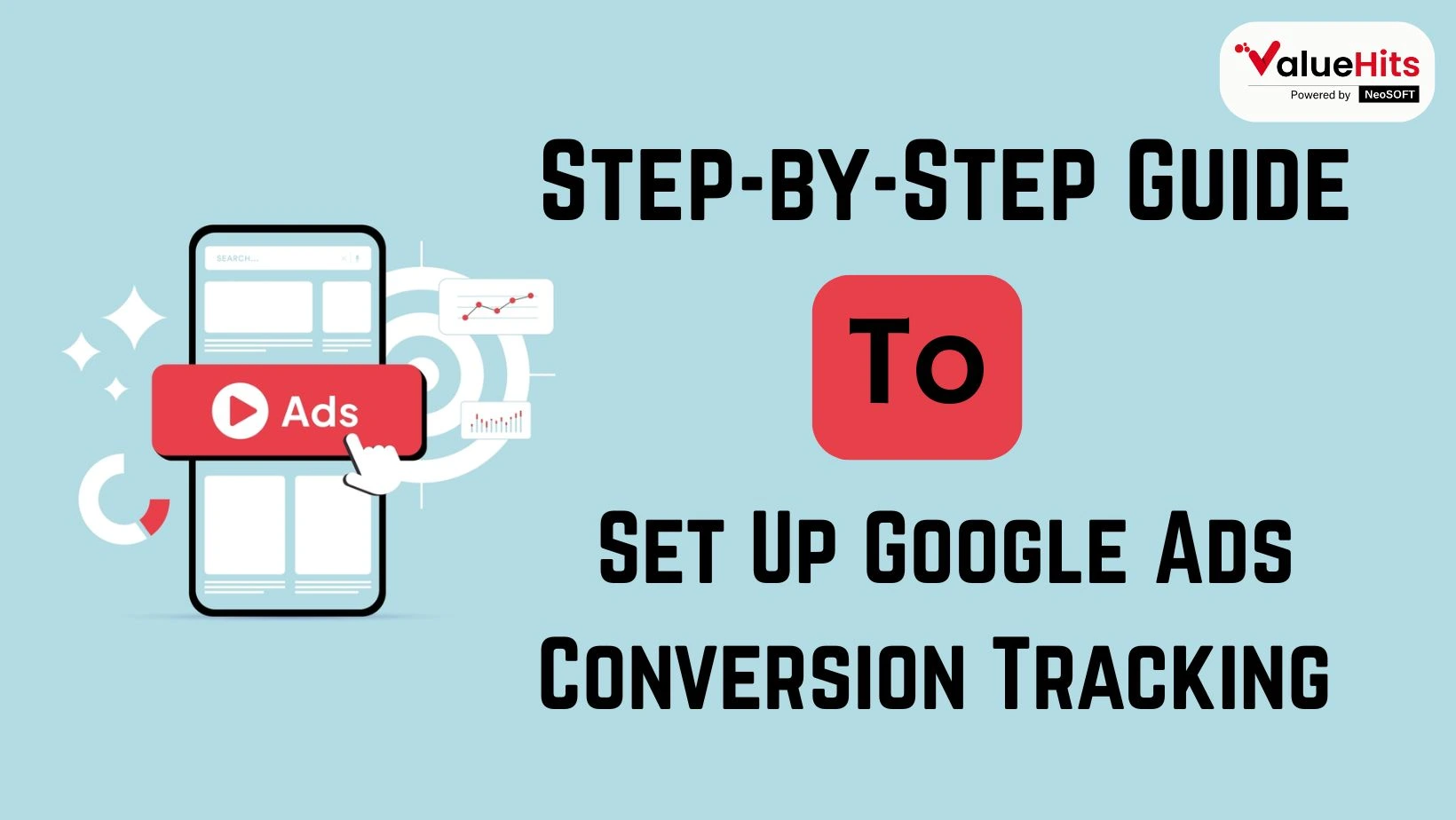KEYWORDS: Google ads conversion tracking conversion tracking google ads set up conversion tracking google ads track Google ads conversions
A Step-by-Step Guide to Set Up Google Ads Conversion Tracking for Different Sources
Digital Marketing | March 7, 2025
Google Ads are a part of digital marketing; therefore, tracking the effectiveness of your ads is an important step for optimizing performance. Google Ads conversion tracking works great by helping advertisers evaluate customer actions on all platforms.
By making the following changes in conversion tracking correctly, businesses can get desired outcomes as needed. This will also improve your decisions for PPC lead conversion to get max ROI.

Why You Need Google Ads Conversion Tracking
It works to help advertisers monitor their campaigns and drive actions, such as purchases, sign-ups, and calls. It offers valuable information about which sources are generating conversions. With this information, businesses can fine-tune their strategies and disperse budgets accordingly.
By setting up tracking, one can improve PPC advertising trends and stay ahead of competitors.
steps To Set up Conversion Tracking Google Ads
![]()
-
Know Your Conversion Goals (What types of conversions can you track with Google Ads?)

Before you start, focus on the specific actions that you desire to track. it could include:
-
Online purchases
-
Form submissions
-
App installs
-
Phone calls
Once you get a clear idea and understanding of your conversion goals, make sure to track and optimize PPC services accurately.
-
-
Produce a Conversion Action in Google Ads (Create your conversion action)
Follow these steps as mentioned below:
-
Sign in to your Google Ads account.
-
Click the tools icon and select "Conversions" under "Measurement."
-
Click the plus button to create a new conversion action.
-
Choose the type of conversion to track: Website, App, Phone Calls, or Import.
-
Add your website name to scan it for existing GTM.
-
Then, you can use website events to create conversion actions or create them manually
-
Choose your setup: URL setup lets you track a specific landing page as a successful conversion, which is easier. while if you need to track any of the button clicks/ form submissions/ manual event tags, then manual setup will be a better choice.

In manual setup, you have better control for tracking particular interactions, for instance, clicks on buttons, interactions, or links. This method allows you to customize your event tag by adding details, such as conversion values, transaction IDs, and other custom parameters. Such a type of customization makes sure the most relevant data is for your business needs.
Here is the detailed process for setting up manual conversion tracking in Google Ads.
If you are setting up conversion tracking based on a URL, follow all these steps as per instructions. Alternatively, if you are setting up the conversion tracking based on a URL, then follow these steps .
The setup process is quite easy; just follow the prompts. While doing this setup, you will also choose your attribution model that determines how credit for conversions is distributed on different touchpoints.
-
-
Apply the Google Tag for Conversions from the Website
For Google Ads conversion tracking on your website:
-
First, install Google Tag Manager or manually add the global site tag to your website.
-
Place the event snippet on the page where the conversion takes place (e.g., thank-you page).
-
Verify tag installation using Google Tag Assistant.
-
-
Set up your Google tag
The next step is setting up Google Ads conversion tracking; it depends on whether your Google tag is already installed on your website.
If you have already set up your Google tag and you have created an action using a URL, you are ready! The conversion tracking will begin collecting data automatically.
If you have not set up your Google tag and you created your conversion action using a URL, you’ll see instructions on-screen guiding you through the entire setup process.
If your Google tag is ready and you have created your conversion action in manual mode, you’ll receive instructions on how to add an event snippet to track a particular conversion.
If your Google tag is not set up and you created your conversion action manually, you’ll need to complete two steps, which are: Install a Google tag on every page of your website and add an event snippet specific to the conversion action you want to track
-
Check your Google Tag
After setting up your Google tab, it is essential to check that it is installed correctly and that tracking conversions is assumed. To conduct this, log into your Google Ads account and go to the Conversions section from the menu. You will find a table listing all your conversion actions. The Status column will give you insights about how the conversion action is performing.
Analyzing your Google Ads conversion data
Once your Google Ads conversion tracking is ready, your account will display valuable data about conversion. To get the most out of this data, make sure that the key columns, such as Conversions (Conv.), Conversion Rate (Conv. Rate), and Cost per Conversion (Cost/Conv.) are visible in your reports. These PPC metrics can help you evaluate your ads performance and confirm maximizing your advertising budget.
-
Tracking from Different Sources
Website Conversions
Check whether the Google tag is added to the page where conversions are taking place. This step will accurately track actions, such as purchases and form submissions, which will contribute to your PPC lead conversion.
App Conversions
If you want to track conversions from apps, use Google Analytics 4 or Firebase to track in-app actions. It will help you know about installs and purchases. Incorporate Google Ads conversion tracking in your app for seamless data generation.
Conversions from Phone Calls
Steps for setting up call tracking:
- Enabling call reporting in Google Ads.
- Using Google forwarding numbers.
- Tracking call length and sources to measure lead quality.
Offline Conversions
You can import offline data in Google Ads if there are offline sales. This will help you combine ad interactions and in-store purchases, improving the tracking of Google Ads conversions.
High Clicks, Low Conversions: What’s Going Wrong?
If your campaign is generating a high number of clicks but very few conversions, it can boost your cost per conversion and negatively affect your ROI. To overcome this issue, consider the following factors:
Are you directing users to a dedicated landing page, or are they directed to your homepage? When traffic is sent to a general homepage it increases the conversion rates. A targeted landing page is tailored as per the ad’s message, which is very effective.
After this, evaluate whether your landing page is properly optimized for conversions. Does it have CTAs? Is the form quick and easy to complete? The important information must be above the fold so that visitors don’t have to search for it.
Lastly, check whether your landing page is relevant to the ad. Does the page have the same and relevant keywords as your ad? When visitors click on the ad, they expect to see what was promised. If the landing page doesn’t align with their expectations, they will leave without converting.
When you address these factors, you can easily improve your conversion rate to make sure that your ad spend leads to positive results.
-
Best Practices for Accurate Conversion Tracking Google Ads
After setting up your Google tab, it is essential to check that it is installed correctly and that tracking conversions is assumed. To conduct this, log into your Google Ads account and go to the Conversions section from the menu. You will find a table listing all your conversion actions. The Status column will give you insights about how the conversion action is performing.
-
Use consistent naming conventions to keep your tracking organized.
-
Set appropriate conversion windows based on your sales cycle.
-
Select the right attribution model, such as data-driven attribution, for better analysis.
-
Regularly analyze conversion data to optimize the performance of your campaign and align with PPC advertising trends.
-
Final Thoughts
And that’s it! Setting up Google Ads conversion tracking correctly is easy. It is essential for measuring the success of your ad campaigns. To get important insights and the best strategies, consult PPC services. Start implementing all the above-mentioned steps today to make your performance better.
FAQ
-
What is Google Ads conversion tracking?
Google Ads conversion tracking is a tool helps advertisers measure actions taken by users after interacting with an ad, such as purchases, sign-ups, or phone calls.
-
Why is Google Ads conversion tracking important?
It allows businesses to understand which ads drive valuable customer actions and helps to optimize ad spending and improve campaign performance.
-
How do I set up conversion tracking in Google Ads?
You need to define conversion goals, create a conversion action in Google Ads, and implement tracking methods such as Google Tag Manager or manual tagging.
-
Can I track conversions from different sources?
Yes, Google Ads supports tracking for website conversions, app installs, phone calls, and offline sales by integrating data from multiple platforms.
-
What are Google forwarding numbers in call tracking?
Google forwarding numbers track calls from ads, providing insights into call duration, sources, and user behavior.
-
How do I track offline conversions in Google Ads?
You can import offline conversion data into Google Ads by syncing CRM data with ad interactions to measure sales performance.
-
What is the best attribution model for conversion tracking?
Data-driven attribution is recommended, as it analyzes user interactions across multiple touchpoints to assign credit accurately.
-
How can I verify if my Google Ads conversion tracking is working?
Use Google Tag Assistant or the "Conversions" section in Google Ads to check if data is being recorded correctly.
Google AI Overview (Formerly Google SGE): How It Works & Why It Matters!
May 15, 2025
What is Google AI Overview?
It is a
15 Social Media Campaign Ideas Aligned with Digital Marketing Trends 2025
March 21, 2025
The digital marketing world evolves frequently; therefore, implementing
E-commerce SEO Strategy: 6 Proven Ways to Rank Higher
March 14, 2025
The success of E-commerce businesses is not a matter of chance but a re
